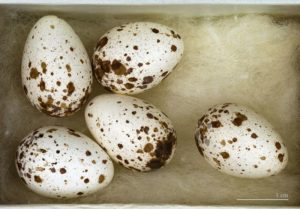You have no items in your cart. Want to get some nice things?
Go shopping
I used to frequent the museum of natural history – to see animals that existed ages ago, before we resembled who we are now, but also to see current specimens: a continuum. During every visit I decided to take one memory home with me. Once it was the enormous antlers of the extinct Irish elk, two palms facing outwards with mismatched fingers. Once it was the armoured husk of an earwig, splaying tendrils of pincers and antennae. Once it was the skeleton of a plesiosaur swimming through an invisible sea.
One day I decided on a clutch of speckled eggs. The faded label read: Barn Swallow. I imagined cradling an egg in my hand, enjoying its calcium contour. I imagined air filtering through microscopic pores to reach the lungs of an infant bird.
Only later, walking home, did I ask myself how the eggs ended up at the museum. The great elk antlers were discovered, the dinosaur bones chiselled from stone. Presumably the earwig met an untimely end, but at least the insect had the chance to grow to maturity. But the eggs? They must have been stolen, the insides drained. What did the mother swallow think when she returned to an empty nest? How long did she mourn, cry out for unborn chicks who could not respond? Who determined these eggs belonged to him? The thief was surely a man. No woman would rob another of her children like so.
If the museum could reward such depravity, what other crimes or misinformation might such an institution convey? How did I know the eggs even belonged to a barn swallow? They had the appearance of barn swallow eggs, but appearances can deceive. No one could see inside. I was suddenly haunted by the idea that the eggs had borne another type of young. A swift or a martin. A hoopoe or an Andean cock-of-the-rock. Even a crocodile or a cobra, or one of those mammalian oddities: a platypus, an echidna.
The next morning when I woke, I couldn’t shake the memory of the eggs. I felt certain that they were not the eggs of a swallow or any species I knew. They belonged to a creature we humans didn’t yet know or understand. And the eggs were not empty – this unknown creature still lay inside – something dormant, something waiting for the right moment to emerge.
I began to visit the museum after work, then during my lunch hour. I fantasised about breaking the glass case, slipping the eggs into my pocket, taking them home. And then what? Put them on the radiator? Or tuck them into my skin? Could I fashion a suit of feathers, or was it scales I would need?
Before long I was staying at the museum after lunch, all afternoon. When my boss found out and threatened me, I gave my notice on the spot. Then I spent all day wandering the museum’s halls, trying to trace a pattern from antlers and pincers to flippers and wings. The speckled eggs still lay in the case, but now they were also inside of me. Each evening when the museum closed, I carried them home. At night I hardly slept, tossing and turning, consumed by waking dreams, imagining the day I would give birth to a miracle only Nature could bestow: uncatalogued, unclassifiable, free.
Claire O'Connor
Claire O’Connor is an educator who has worked with students of many ages in New York, California, Idaho, Morocco, Malaysia, Greece, South Africa, and Scotland. Her stories have appeared in the Baltimore Review, Best New American Voices, Fiction Circus, LEON Literary Review, Shenandoah, the Southern Indiana Review, and Wigleaf, and she has previously won The Missouri Review’s Miller Audio Prize for prose. She lives with her wife in Scotland and various other parts of the world.




